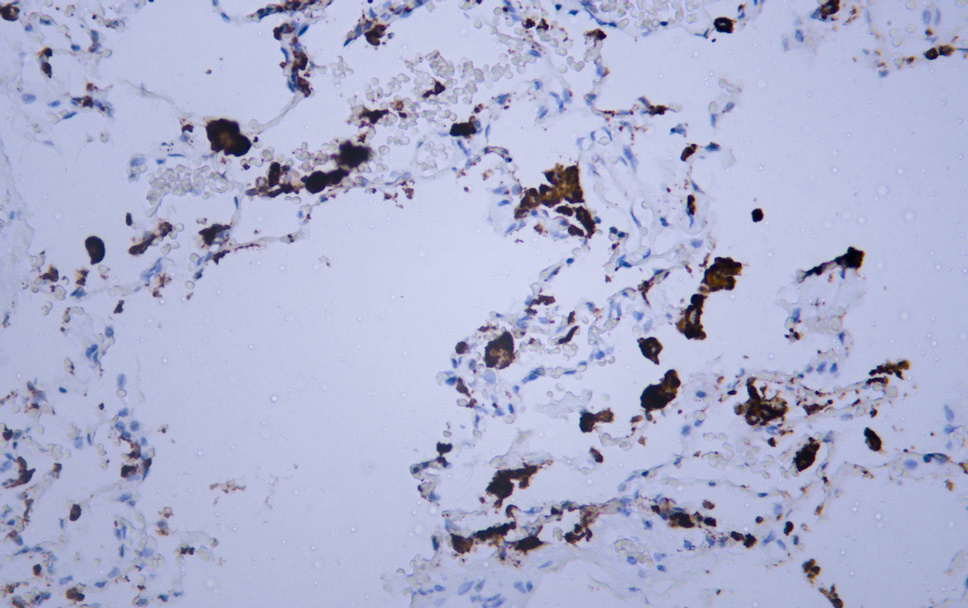Napsin A (ABT-ASP4) mouse mAb (Ready to Use)
- Catalog No.:YM6692R
- Applications:IHC
- Reactivity:Human;Mouse;
- Target:
- Napsin A
- Fields:
- >>Lysosome
- Gene Name:
- NAPSA NAP1 NAPA
- Protein Name:
- Napsin A
- Human Gene Id:
- 9476
- Human Swiss Prot No:
- O96009
- Immunogen:
- Synthesized peptide derived from human Napsin A AA range: 100-200
- Specificity:
- The antibody can specifically recognize human Napsin A protein.
- Formulation:
- The prediluted ready-to-use antibody is diluted in phosphate buffer saline containing stabilizing protein and 0.05% Proclin 300
- Source:
- Mouse, Monoclonal/IgG1, kappa
- Dilution:
- Ready to use for IHC
- Purification:
- The antibody was affinity-purified from ascites by affinity-chromatography using specific immunogen.
- Storage Stability:
- 2°C to 8°C/1 year
- Other Name:
- Napsin-A (EC 3.4.23.-;Aspartyl protease 4;ASP4;Asp 4;Napsin-1;TA01/TA02)
- Background:
- This gene encodes a member of the peptidase A1 family of aspartic proteases. The encoded preproprotein is proteolytically processed to generate an activation peptide and the mature protease. The activation peptides of aspartic proteinases function as inhibitors of the protease active site. These peptide segments, or pro-parts, are deemed important for correct folding, targeting, and control of the activation of aspartic proteinase zymogens. The encoded protease may play a role in the proteolytic processing of pulmonary surfactant protein B in the lung and may function in protein catabolism in the renal proximal tubules. This gene has been described as a marker for lung adenocarcinoma and renal cell carcinoma. [provided by RefSeq, Feb 2016],
- Function:
- function:May be involved in processing of pneumocyte surfactant precursors.,similarity:Belongs to the peptidase A1 family.,tissue specificity:Expressed predominantly in adult lung (type II pneumocytes) and kidney and in fetal lung. Low levels in adult spleen and very low levels in peripheral blood leukocytes.,
- Subcellular Location:
- Cytoplasmic
- Expression:
- Expressed predominantly in adult lung (type II pneumocytes) and kidney and in fetal lung. Low levels in adult spleen and very low levels in peripheral blood leukocytes.
- June 19-2018
- WESTERN IMMUNOBLOTTING PROTOCOL
- June 19-2018
- IMMUNOHISTOCHEMISTRY-PARAFFIN PROTOCOL
- June 19-2018
- IMMUNOFLUORESCENCE PROTOCOL
- September 08-2020
- FLOW-CYTOMEYRT-PROTOCOL
- May 20-2022
- Cell-Based ELISA│解您多样本WB检测之困扰
- July 13-2018
- CELL-BASED-ELISA-PROTOCOL-FOR-ACETYL-PROTEIN
- July 13-2018
- CELL-BASED-ELISA-PROTOCOL-FOR-PHOSPHO-PROTEIN
- July 13-2018
- Antibody-FAQs
- Products Images

- Human lung tissue was stained with Anti-Napsin A (ABT-ASP4) Antibody
.jpg)
- Human lung adenocarcinoma tissue was stained with Anti-Napsin A (ABT-ASP4) Antibody
.jpg)
- Human lung adenocarcinoma tissue was stained with Anti-Napsin A (ABT-ASP4) Antibody



